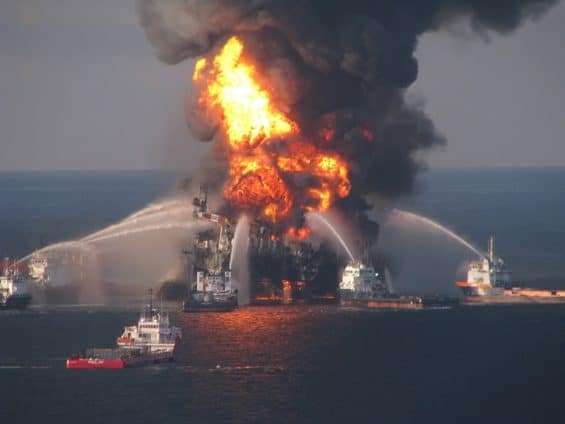Home » Spotlight • US business news » 10 Business Disasters That Caused Huge Environmental Damage
10 Business Disasters That Caused Huge Environmental Damage
https://www.whatjobs.com/news/usa/us-business-news/10-business-disasters-that-caused-huge-environmental-damage

By Hugh Fort in Spotlight, posted April 11, 2024

Business operations can sometimes go awry, leading to unforeseen environmental catastrophes.
These result in huge fines and sometimes even criminal convictions for those involved.
They also often cause years and years of damage to areas which often never recover.
This article highlights ten significant incidents where business activities resulted in substantial environmental damage, underlining the importance of sustainable practices and stringent regulatory oversight.
Deepwater Horizon Oil Spill (2010)
The Deepwater Horizon oil rig explosion in the Gulf of Mexico is considered to be one of the worst environmental disasters in history.
Operated by BP, this incident released approximately 4.9 million barrels of oil into the ocean, devastating marine life and local economies.
In the wake of the catastrophe, BP faced substantial legal and financial penalties.
The company pleaded guilty to 11 counts of manslaughter, two misdemeanors, and one felony count of lying to Congress, agreeing to a $4 billion fine—the largest criminal penalty in U.S. history at the time.
BP's settlement with the U.S. government and five states amounted to $20.8 billion.
This was primarily for environmental restoration and economic compensation, pushing the total costs and penalties over $65 billion.
Bhopal Gas Tragedy (1984)
Union Carbide Corporation's pesticide plant in Bhopal, India, leaked methyl isocyanate gas.
This exposed more than 500,000 people to toxic chemicals.
The immediate death toll neared 3,800, with long-term environmental and health repercussions still felt today.
The disaster sparked numerous legal battles for compensation and accountability, both in India and the USA.
In 1989, Union Carbide Corporation (UCC) agreed to a settlement of $470 million with the Government of India, a figure many considered insufficient for the scale of the disaster.
Legal and civil cases continued for years, seeking further compensation and cleanup of the contaminated site.
Chernobyl Disaster (1986)
The Chernobyl disaster is one of the most famous environmental disasters in history.
An explosion at the nuclear power plant in Ukraine, then part of the Soviet Union, released large quantities of radioactive particles into the atmosphere.
This disaster had far-reaching effects on human health, agriculture, and wildlife across Europe.
The aftermath saw over 500,000 workers mobilized to contain the contamination, with the Soviet government eventually evacuating approximately 335,000 people from severely affected areas.
The disaster significantly impacted local ecosystems and human health, leading to an increase in cancer rates among the exposed populations.
The Soviet legal system held several individuals directly accountable for the disaster.
In 1987, the plant manager, the chief engineer, and their subordinates were found guilty of gross violation of safety regulations and sentenced to prison terms ranging from two to 10 years.
The Soviet government also faced international criticism for its handling of the incident and lack of transparency.
The disaster prompted a reevaluation of global nuclear safety standards and procedures, leading to stricter regulations and oversight in the nuclear industry.
However, many argue that the punitive measures were insufficient in addressing the magnitude of the catastrophe and its long-term consequences on health and the environment.
Exxon Valdez Oil Spill (1989)
The Exxon Valdez oil spill is one of the most notorious environmental disasters in U.S. history.
It happened on March 24, 1989, when the Exxon Valdez, an oil tanker owned by Exxon Shipping Company, struck Prince William Sound's Bligh Reef in Alaska.
This accident resulted in the spillage of approximately 11 million gallons of crude oil, covering an area of 1,300 miles of coastline, and severely affecting marine life, birds, and the local fishing industry.
The disaster sparked widespread public outrage and led to significant legal and environmental action.
Exxon faced both criminal and civil charges, resulting in a complex series of lawsuits and settlements.
Initially, in 1991, Exxon agreed to pay $1 billion under a consent decree with the United States and the state of Alaska to settle various criminal and civil charges.
This included fines, penalties, and the costs of the cleanup operation.
There was also compensation for damages to natural resources.
But further legal action saw Exxon Mobil (the company formed after Exxon's merger with Mobil) paying additional amounts, including a punitive damages award to fishermen and other affected parties.
This punitive damages award was subject to prolonged litigation, with the original 1994 jury verdict of $5 billion being reduced several times upon appeal.
Ultimately, in 2008, the U.S. Supreme Court drastically reduced the punitive damages to $507.5 million.
The Exxon Valdez disaster led to significant changes in oil transportation regulations, including the passage of the Oil Pollution Act of 1990.
This imposed stricter requirements on the oil industry, notably mandating the phase-out of single-hull oil tankers in U.S. waters.
Minamata Disease (1956)
In 1956, Chisso Corporation's chemical factory in Minamata, Japan, discharged methylmercury into Minamata Bay.
The mercury bioaccumulated in fish, leading to severe mercury poisoning (Minamata disease) among local populations and wildlife.
Thousands of people were affected by mercury poisoning, showing symptoms ranging from muscle weakness and numbness in limbs to severe birth defects and neurological syndromes.
Official figures have recognized over 2,000 victims, including deaths and severe health afflictions, though actual numbers are believed to be higher.
It was not until 1968 that the Chisso Corporation was officially acknowledged as the source of the mercury pollution.
More lawsuits led to compensation agreements in the 1970s and beyond, with several legal battles continuing into the 21st century.
The Aral Sea Desiccation
Diversion of rivers for irrigation by Soviet agricultural programs led to the shrinkage of the Aral Sea, once the world's fourth-largest lake.
This ecological disaster destroyed local fishing communities and created health problems due to the dusty, pesticide-laden seabed.
Punishments or legal actions regarding the environmental mismanagement that led to the Aral Sea's desiccation have been minimal.
Efforts to address the consequences have largely focused on mitigation and rehabilitation rather than retribution.
The international community, along with the affected countries, has initiated several projects aimed at reviving the remaining northern part of the Aral Sea and improving water management practices.
The construction of a dam in 2005 has led to a partial recovery of the North Aral Sea, improving local ecosystems and fishing communities.
Love Canal Chemical Waste Dumping (1970s-1980s)
The Love Canal tragedy, emerging in the late 1970s in Niagara Falls, New York, stands as a pivotal moment in American environmental history.
The site was initially a canal envisioned as a dream community by its namesake, William T. Love.
But it was abandoned in the 1890s and eventually became a chemical waste dump for the Hooker Chemical Company (later acquired by Occidental Petroleum) in the 1940s and 1950s.
The company buried over 21,000 tons of toxic waste in the canal before covering it with earth and selling the land to the Niagara Falls School Board for $1, with a warning of the chemical waste buried beneath.
In the 1950s and 1960s, a neighborhood was developed over the landfill site, including homes and an elementary school.
By the late 1970s, heavy rainfall led to the leaking of toxic waste.
This contaminated the surrounding soil and groundwater.
Residents reported unexplained illnesses, birth defects, and miscarriages, which were eventually linked to the chemical exposure.
The situation gained national attention in 1978.
It led to the evacuation of families by the federal government and the declaration of the area as a federal health emergency.
This crisis was a key factor leading to the establishment of the Comprehensive Environmental Response, Compensation, and Liability Act (CERCLA), commonly known as the Superfund Act, in 1980.
In 1995, Occidental Petroleum agreed to pay $129 million to the federal government to settle its liability in the Love Canal case.
The settlement was intended to cover the costs of cleaning up the Love Canal site and compensating the affected families for the health and environmental damages caused by the chemical waste dumping.
The Great Smog of London (1952)
In 1952, cold weather led to people in London burning more coal than usual, which caused an increase in air pollution.
The situation was made worse by an an anticyclone that settled over the region, trapping cold air under a layer of warm air (a temperature inversion) and confining the pollutants close to the ground.
The smog was dense and a yellowish-black in colour.
It was so thick it was hard to see and got into people's homes for around five days.
It caused significant disruption, including to transport and healthcare services.
It is estimated to have resulted in the deaths of around 4,000 to 12,000 people, primarily from respiratory tract infections and exacerbations of pre-existing lung and heart conditions.
An additional 100,000 people were reported to have been made ill by the smog's effects on the respiratory system.
The disaster served as a wake-up call regarding air pollution and led to significant policy changes in the United Kingdom.
In response, the Clean Air Act was passed in 1956, which aimed to reduce air pollution by controlling domestic sources of smoke pollution and relocating power stations away from cities.
The Act also promoted the use of smokeless fuels and authorized local councils to set up smoke control areas where only smokeless fuels could be burned. These measures led to a significant improvement in air quality in London and other cities in the UK.
The incident was unusual as it wasn't really anyone's fault, and so there weren't any punishments dished out.
The Clean Air Act and its subsequent amendments have been credited with dramatically improving air quality in the UK and have served as a model for other countries facing similar issues.
Fukushima Daiichi Nuclear Disaster (2011)
Following a tsunami, the Fukushima Daiichi nuclear power plant in Japan experienced multiple reactor meltdowns, releasing radioactive materials into the environment.
In the immediate aftermath, the Japanese government evacuated around 154,000 residents from the vicinity of the plant due to the release of radioactive materials and established a 20-km exclusion zone.
The disaster raised serious concerns about the safety of nuclear power, leading to a reevaluation of nuclear energy policies worldwide.
In Japan, the government shut down all of its nuclear reactors for inspections and safety upgrades, with a gradual process to restart those meeting new safety standards.
Tokyo Electric Power Company (TEPCO), the operator of the Fukushima Daiichi Nuclear Power Plant, faced significant criticism for its handling of the disaster and for inadequate safety measures.
The company's executives were legally challenged in several cases.
In 2019, three former executives of TEPCO were acquitted of negligence over the disaster by a Tokyo court, a decision that sparked controversy and disappointment among the affected residents and the general public.
The court ruled the bosses could not have predicted a tsunami of the magnitude that hit the plant and led to the accident.
The aftermath of the disaster has seen ongoing efforts to decommission the plant, a process expected to take decades and involve significant challenges.
One of these is the removal of the melted nuclear fuel.
Sine the disaster there has been extensive work on decontaminating the affected areas, with many residents being allowed to return to their homes in zones where the government has lifted evacuation orders.
However, some areas remain off-limits due to high radiation levels.
Need Career Advice? Get employment skills advice at all levels of your career
Ok Tedi Environmental Disaster (1984-Present)
This disaster is centered around the Ok Tedi Mine in Papua New Guinea (PNG).
The copper mine, situated near the headwaters of the Ok Tedi River in the Western Province, began operations in 1984.
The disaster unfolded as a consequence of the mine's continuous discharge of mining waste (tailings) and effluents into the Ok Tedi and Fly River systems over several decades.
The disposal of tailings and waste rock into local river systems resulted in the sedimentation and contamination of waterways, affecting over 1,000 kilometers of rivers.
There was significant damage to the aquatic ecosystem and a drastic reduction in fish populations, crucial for the diet and economy of local communities.
There was destruction of forested areas and floodplains due to sediment deposition.
The incident also caused long-term health and social issues for the local indigenous populations.
These were people who relied on the river systems for sustenance, cultural, and economic activities.
In 1994, a lawsuit was filed against BHP (then the mine's majority shareholder) by the local landowners for environmental damages.
This led to a settlement in 1996, where BHP committed to funding a remediation and support program, although the mine continued to operate and dispose of waste into the river system.
BHP's Exit: In 2002, BHP Billiton (formed after a merger) divested its holdings in the mine, citing environmental reasons, and transferred its stake to a trust for the benefit of the PNG community.
This move was part of an attempt to address the environmental and social issues caused by the mine, albeit the damage was already extensive.
Despite the environmental catastrophe, the PNG government and subsequent operators continued the mine’s operations, emphasizing its economic significance to the region.
The government and mining entities faced criticism for prioritizing economic benefits over environmental and social welfare.
Remediation and support efforts have been ongoing since the disaster 40 years ago.
Initiatives aimed at environmental monitoring, community support, and sustainable practices have been launched.
However, the scale of the disaster means that full recovery is a long-term process, with some of the damage being irreversible.
Follow us on YouTube, X, LinkedIn, and Facebook














